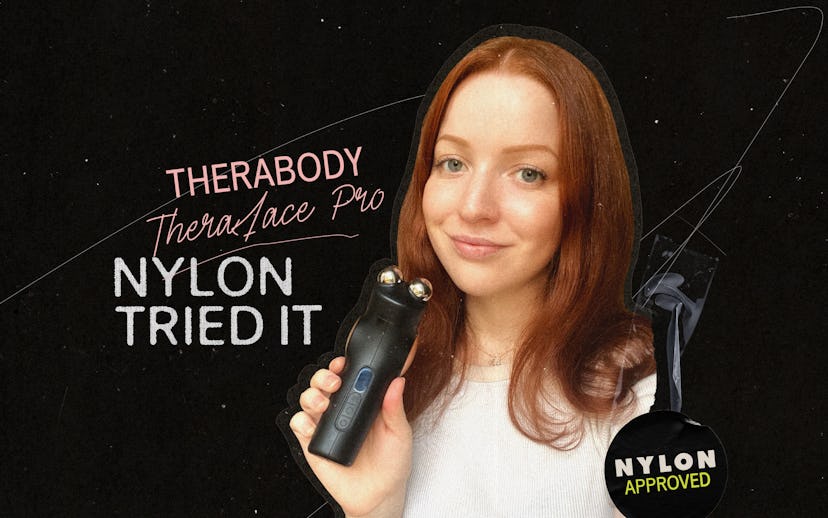
Beauty
An Honest Review Of The TheraFace Pro
The latest high-tech beauty gadget to hit the market targets several skin concerns, all while offering a relaxing massage.
As beauty enthusiasts search for the latest cutting-edge treatments for pandemic-weary skin, high-tech devices designed for at-home use have flooded the market, each offering their own promises of clearer, smoother, more lifted skin. Many of them, though, have things in common: they target different layers of skin with light therapy for smoother appearance, lift the face with some form of safe, low-voltage currents, and improve overall complexion by stimulating collagen and boosting circulation by targeting cells. Therabody, widely known for their best-selling, high-grade at-home massager, the Theragun, has created a device that claims to do all three. The TheraFace Pro combines microcurrent technology, LED light therapy, and the percussive technology of a massager to treat multiple concerns from the comfort of your home.
Read on for NYLON’s honest review of the TheraFace Pro:
FAST FACTS:
- Brand: Therabody
- Price: $399
- What is it? The TheraFace, from the makers of the super popular Therabody massaging gun, combines the percussive aspect of the Theragun with skin-toning microcurrent technology and rejuvenating light therapy to benefit overall skin health. The handheld device has several attachments — for massaging and releasing muscle tension in your jaw, neck, and face, as well as the microcurrent and light therapy attachments for treating skin concerns like fine lines.
- Who is it for? Anyone who wants both a relaxing massage combined with high-tech skin toning.
- Where can you buy? therabody.com
How To Use:
To use the TheraFace’s microcurrent attachment, you’ll first need to wash and prep your face with the included conductive gel (using gel is an absolute must in order for the currents to penetrate deeper layers of skin, and to keep the top layer from being irritated). Then, gently glide the device with an upward motion over your face and neck. To get the best results, you’ll need to do this consistently, ideally each day — adding it into your nightly skincare routine is relatively simple.
The light attachments include Blue and Red LED light therapy rings. Once the attachments are on, simply point the device at the areas of skin you want to treat and hover; the device will beep after 15 seconds to let you know you can move onto another area.
Each therapy can be used for a maximum of eight minutes; the device will beep three times to let you know the maximum time has been reached.
The percussive attachment is essentially a mini Theragun; there are three levels of intensity you can choose from before pressing the device against your skin and letting it work its magic on tense or tired muscles around the jaw lines, cheeks, neck, and shoulders.
(Each attachment has its own step-by-step guide and safety precautions that should be carefully followed.)
How Does It Work?
Microcurrent devices work by delivering a low-voltage electrical current to muscles and skin cells, which some believe stimulates both collagen and a tightening of the connective tissues in your face, by increasing cellular activity. While microcurrent technology can be delivered in-office by dermatologists and some spas, at-home devices like the TheraFace offer the opportunity to get similar results over a longer period of consistent use.
Some doctors and experts believe the devices can help boost collagen production, improve blood circulation, and assist with lymphatic drainage, resulting in skin that looks firmer, smoother, less puffy, and more lifted — with the benefit of a brighter complexion, thanks to the circulation boost. More long-term studies need to be done on the effectiveness of microcurrent devices, but that hasn’t stopped their spike in popularity.
As for the red and blue light attachments, LED light therapy is another popular skin treatment that can be delivered both in-office and with at-home beauty gadgets like the TheraFace. According to the Cleveland Clinic, Red LED light therapy may reduce inflammation and stimulate the production of collagen, while Blue LED light may destroy acne-causing bacteria. Both red and blue wavelengths are readily absorbed into the skin and do not contain harmful UV light. Especially with the milder wavelengths offered by at-home devices, consistent use is needed to see results.
Results:
I used the TheraFace consistently for a month, and did find overall that my skin felt and looked smoother, brighter, and more lifted. I was already a fan of LED light therapy, and do think it makes my skin complexion more even, as well as helps target breakouts as they start to show up, stopping them in their tracks. I can’t say the TheraFace dramatically changed the shape of my face, but that’s not what it’s meant to do. It’s more of a gentle lift around areas like the jawline and cheeks — I saw the biggest difference after about two weeks of consistent use with it leveling out after that.
Final Verdict:
By far, my favorite aspect of the TheraFace was the percussive attachment. I suffer from TMJ, and having a small but mighty handheld device to use on my jaw and neck feels, honestly, like heaven. The microcurrent and LED attachments were an added benefit, but it was the tiny TheraGun of it all that made me return to this device again and again. In general, I appreciate taking the time to slow down my nightly skincare routine with these extra steps, and adding a little more love to the deeper layers of my skin. I look forward to seeing where my skin is at after two, three, and six months of use.